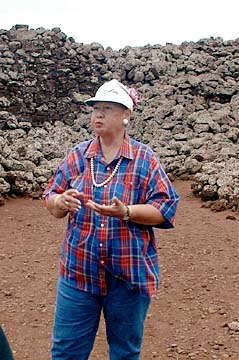


Woman’s devotion NORTH KOHALA, Hawaii >> Surrounded by lichen-crusted stone walls, a teenage girl is sobbing uncontrollably.
to heiau is
emotion-filled
Leimomi Lum has cultivated
a sense of the spirit at an
ancient Hawaiian holy siteBy Rod Thompson
rthompson@starbulletin.comA grandmotherly woman in a plaid shirt and blue jeans is urging the girl to cry more. The woman has seen tears here before.
"I tell them to release it -- all the pent-up emotions from the day they were born," says Leimomi Mookini Lum.
Lum is the kahuna nui of Mookini Heiau, a 1,500-year-old walled temple enclosure at the northern tip of the Big Island.
This heiau over which she is the high priestess has long been linked to strong emotion. It is a luakini heiau, the kind once used for human sacrifices.
Now it is a healing heiau, where a teenage girl releases her inner confusion and where Lum teaches visitors that they have inner energy they must use to help and heal others.
She tells visitors, young and grown, to put their fingertips almost together, not quite touching.
"Do you feel that?" she asks. "It feels like gum. It's your energy."
When a child is injured, the mother rubs the sore spot. She's pushing out the pain, Lum says.
Rambunctious boys can do the same, she says. "Sometimes you young boys get hurt. Take care of each other. Run over there (to a hurt friend) and do it."

This is a far cry from human sacrifices. In 1978, Lum rededicated the heiau to the children of Hawaii. "I lifted one kapu to make it safe for children," she says. In 1994 she rededicated it again, this time to the children of the world.It's a change in status not understood by everyone. "They're still afraid, absolutely," she says of some of the heiau's North Kohala neighbors. "They talk about it. They say things. But they don't understand it."
The same was true in her childhood, when the heiau was surrounded by the thriving Kohala Sugar Co. and her Uncle Heloke Mookini was the kahuna nui.
"Nobody came here. They were all scared of it. This was a no-no."
At one corner of the heiau was the house of the mu, an official whose job in olden days was to go out and grab people for sacrifices. Misbehaving children were told the mu would get them, like the bogeyman in Western culture, except the mu was a real person.
The heiau is located down an unmarked road, blocked by two gates to discourage thieves. Stones have been stolen from it before.
Every third Saturday of the month Lum offers people an opportunity to visit the heiau in what is really an understated invitation to a "weed pulling workday."
The visitor learns the weed pulling is really an offering, which Lum rewards with knowledge.
One who made the offering recently was Kahele Miura of Hilo. "I'm a makaainana, a commoner. So I came to work." he said.

And he was rewarded. "This barren, open, wind-blown area, this is unreal. I feel today Auntie and I were at times somehow connected. I've been here at times long ago," he said.Lum visited the heiau as a girl, but never expected to be kahuna nui. In the early 1960s she was happily working with juveniles as the Honolulu Police Department's first woman officer when Uncle Heloke made a proposal.
"Babe, do you think you can take the next generation?" he asked.
She answered, "Uncle, eyeball to eyeball, I don't think so."
But her father, Honolulu assistant police chief Dewey Mookini, said, "I have four sons and a daughter. That girl will live up to your expectations."
Uncle Heloke, kahuna nui from 1930 to 1966, was succeeded by Lum's father, who held the post until his death in 1977.
When Lum became kahuna nui, she was the seventh woman to hold the office in 1,500 years.
She is a devout Catholic. "I was brought up at Sacred Hearts Convent and Sacred Hearts Academy," she says. She denies that the heiau is pagan, associating Hawaii's old gods with the Christian trinity, and seeing an ultimate unity.
Every year in November she holds a Children's Day with as many as 2,000 attending. Last year she planned to cancel it for lack of money until Mayor Stephen Yamashiro came through with county buses for transportation and McDonald's supplied free drinks for the kids in the dry, windswept area.
Lum is talking the same way again. "I'm not going to have Children's Day (this year) because I have no money," she says.
When she says that, you may realize the words aren't meant for you.
With a twinkle in her eye, she's dropping a hint to the Supreme Being. "He's listening," she says.